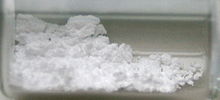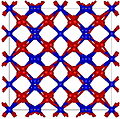Europium(III) oxide
Appearance

| |
| Identifiers | |
|---|---|
3D model (JSmol)
|
|
| ChemSpider | |
| ECHA InfoCard | 100.013.787 |
PubChem CID
|
|
CompTox Dashboard (EPA)
|
|
| |
| |
| Properties | |
| Eu2O3 | |
| Molar mass | 351.926 g/mol |
| Appearance | White powder. |
| Density | 7.40 g/cm3 |
| Melting point | 2350 °C[1] |
| Negligible | |
| Structure | |
| Monoclinic, Cubic | |
| Hazards | |
| Occupational safety and health (OHS/OSH): | |
Main hazards
|
Non-Toxic |
| Related compounds | |
Other anions
|
Europium(III) chloride |
Other cations
|
Samarium(III) oxide, Gadolinium(III) oxide |
Except where otherwise noted, data are given for materials in their standard state (at 25 °C [77 °F], 100 kPa).
| |
Europium(III) oxide (Eu2O3), is a chemical compound of europium and oxygen. It is widely used as a red or blue phosphor in television sets and fluorescent lamps, and as an activator for yttrium-based phosphors. It is also an agent for the manufacture of fluorescent glass. Europium fluorescence is used in the anti-counterfeiting phosphors in Euro banknotes.[2]
Europium oxide has two common structures: Monoclinic (mS30, SpaceGroup = C2/m, No. 12) and cubic (cI80, SpaceGroup = Ia-3, No. 206). The cubic structure is similar to that of manganese(III) oxide.
It may be formed by ignition of europium metal.
It can react with acids to form the corresponding europium(III) salts.
Gallery
-
Cubic Eu2O3
-
Monoclinic Eu2O3
References


